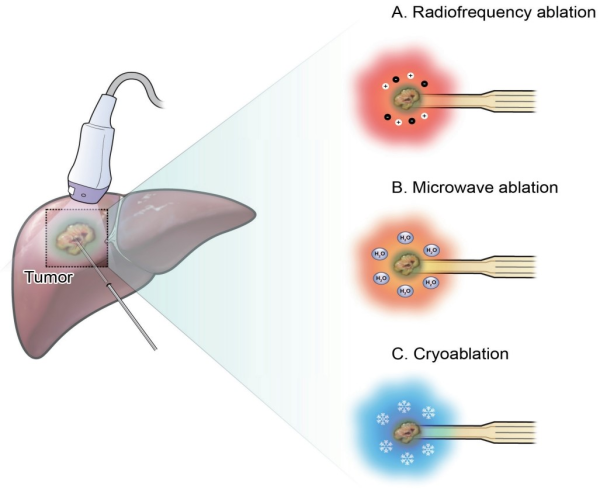Advantages
- Minimally Invasive: RFA is a procedure performed with minimal incisions and is generally less invasive than surgery.
- Short Hospital Stay: Patients can usually return to their normal activities shortly after the procedure.
- High Efficacy: Shows high success rates, especially in small and medium-sized tumors.
Disadvantages
- Limited Tumor Size: RFA may have limited effectiveness in large or multiple tumors.
- High Heat Waves: The high temperatures generated during the procedure can damage surrounding tissues.
- Risk of Recurrence: In some cases, there may be a risk of tumor recurrence after the procedure.
Microwave Ablation (MWA)
What is MWA?
Microwave ablation (MWA) is another minimally invasive method used in the treatment of tumors. This method uses microwave energy to heat and destroy tumor tissue. MWA is commonly used for tumors in the liver, kidney, and lung, as well as thyroid nodules and other benign lesions.
Mechanism of Action
The MWA procedure consists of the following steps:
- Preparation: The patient undergoes the procedure under local anesthesia or sedation. Imaging techniques are used to locate the tumor.
- Microwave Probe Placement: A thin microwave probe is inserted into the tumor. This probe transmits microwave energy to the tumor tissue.
- Heat Generation and Ablation: Microwave energy generates high temperatures in the tumor tissue. This heat coagulates and destroys the tumor cells.
- Recovery Process: After the procedure, the patient usually remains under observation for a few hours and is then discharged. The recovery process is generally rapid.
Advantages
- Rapid Heat Generation: MWA generally generates heat faster than RFA and yields results in a shorter time.
- Effectiveness in Larger Tumors: MWA can be effective in larger tumors because microwave energy can have deeper tissue penetration.
- Targeting Precision: Microwave energy provides better control over the targeted tissue.
Disadvantages
- Risk of Damage to Surrounding Tissues: High temperatures can damage surrounding tissues.
- Equipment Cost: MWA equipment can generally be more expensive and may be limited in some healthcare institutions.
- Risk of Recurrence: There may be a risk of tumor recurrence after the procedure.
Clinical Uses and Efficacy
RFA and MWA are used in various clinical situations and are generally effective methods for local tumor control:
- Liver Tumors: Both RFA and MWA offer an effective treatment option for liver tumors. They show high success rates in small and medium-sized tumors.
- Kidney Tumors: Effective especially in small kidney tumors, these methods offer an alternative to surgery.
- Lung Tumors: Used in lung tumors, especially in patients who are not candidates for surgery or have a high surgical risk.
- Thyroid Nodules: RFA and MWA can be used in the treatment of thyroid nodules, especially if the nodules are benign and not suitable for surgery.
Conclusion
Radiofrequency ablation (RFA) and microwave ablation (MWA) play a significant role in the treatment of tumors as minimally invasive methods. Both methods offer highly effective, targeted treatment options and can be used as alternatives to surgery. While RFA is effective in smaller tumors, MWA provides advantages in larger tumors and deeper tissues. Both methods have their advantages and disadvantages, and the appropriate method should be selected by considering the patient profile, tumor characteristics, and other clinical factors.
This information has been verified with medical information confirmed by specialist physician İbadat Hasanov and aims to inform individuals. In any case, the treatment plan is determined specifically for you, and this decision is meticulously evaluated by your doctors.
































